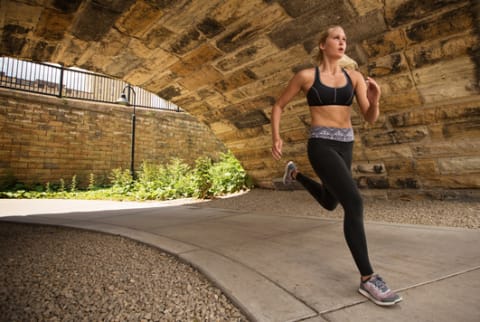Advertisement

If you have ever experienced pain along the inner edge of your shin — commonly referred to as "shin splints" — you know how painful this condition is. In fact, the pain experienced from shin splints can be so debilitating that it will actually put you on the sidelines by forcing you to cut your activity level back.
Yep, shin splints are pretty awful. So let's talk about them.
What are shin splints?
The term "shin splints" is used to describe lower leg pain that occurs below the knee in two areas. The first is the front of the leg on the outside of the tibia (shin bone) called anterior shin splints, and the second is on the inside of the leg called medial shin splints. This condition can affect everyone from runners, dancers, and soccer players to football players and tennis players.
What causes shin splints?
Most of the time, shin splints are caused by increasing your training by running too much or too fast. If you are a beginning runner, it's usually from starting out too aggressively, building your mileage too fast, not getting enough rest time in, or doing too much speed work.
In experienced runners, shin splints can be caused by changing flat runs to hill work, too much speed work, changing footwear to a new manufacturer, not changing running shoes frequently enough, or adding too much mileage too soon.
The most common area of pain in shin splints is the medial area or inside the shin bone. The common consensus is that there are micro-tears in the muscle where it is pulled off the bone, which then tears the covering of the bone creating a periostitis. The nerve fibers and blood supply in the periosteum is very extensive, therefore disruption of that area results in sharp pain.
Continual tearing by running or any sport will create sharp pain and disability, which will not go away without rest. Anterior shin splints have a number of specific causes.
Sometimes, athletes that have a restriction that prevents the ankle joint from flexing (when the top of the foot gets closer to the shin) the muscles in the front of the shin actually have to lift the foot to prevent tripping. This creates an overuse injury and then shin splints.
It's also worth noting that shin splints can be caused by tight calf muscles preventing the ankle from bending properly.
Let's talk about compartment syndrome.
Another condition that may mimic shin splints is compartment syndrome. When training, muscles get bigger and swell. These muscles are encased in fascia, which covers and encases them in specific compartments. When the muscles swell in these closed compartments, it creates pressure, which causes pain, may create weakness, and may also create neurological sensations.
The third differential diagnosis for lower leg pain is a stress fracture (an incomplete crack in the bone). This shows as a very distinct point of pain where the fracture occurs. Shin splints are a more general type of pain and are exacerbated by flexing your foot to your shin. Stress fractures can be diagnosed with X-rays after about two weeks and can also be evaluated by a bone scan.
Stress fractures will feel better in the morning since you have not been bearing weight at night whereas shin splints will hurt upon stepping on the foot since the soft tissue develops adhesions at night and walking tears the adhesions.
So, how can I treat and prevent shin splints?
Once you start to notice shin splints, stop activity completely and ice. Then get a good natural anti-inflammatory nutritional supplement.
Next, start stretching the Achilles and anterior and medial leg muscles two times per day, being careful not to overstretch. And in the meantime, pool running and swimming are good alternatives that help to keep your cardio conditioning up.
When you start to run again, keep your mileage and speed low. Increase your mileage between 5 and 10 percent. Pay attention to any pain you feel.
It's also important to lay off the hills until the pain is gone and get evaluated for good footwear, and you may even want to consider getting a biomechanical computerized gait evaluation by a sports podiatrist to see if your problem is coming from your feet.
Most of all, common sense rules the case here. Most people who get shin splints are pretty driven athletes (that's what got you here in the first place) so don't rush the rehabilitation. Being too aggressive can seriously slow down your recovery.
Watch Next
Enjoy some of our favorite clips from classes
Enjoy some of our favorite clips from classes
What Is Meditation?
Mindfulness/Spirituality | Light Watkins
Box Breathing
Mindfulness/Spirituality | Gwen Dittmar
What Breathwork Can Address
Mindfulness/Spirituality | Gwen Dittmar
The 8 Limbs of Yoga - What is Asana?
Yoga | Caley Alyssa
Two Standing Postures to Open Up Tight Hips
Yoga | Caley Alyssa
How Plants Can Optimize Athletic Performance
Nutrition | Rich Roll
What to Eat Before a Workout
Nutrition | Rich Roll
How Ayurveda Helps Us Navigate Modern Life
Nutrition | Sahara Rose
Messages About Love & Relationships
Love & Relationships | Esther Perel
Love Languages
Love & Relationships | Esther Perel


















